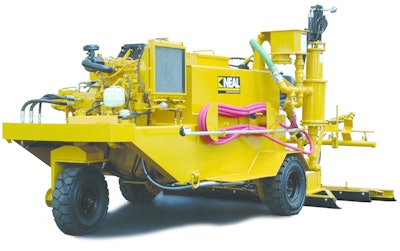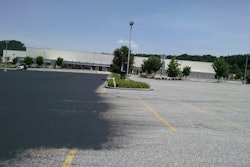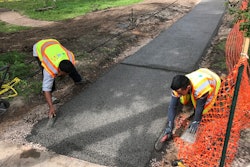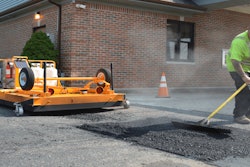
Maximizing return on investment doesn’t take a mathematician. For sealcoat contractors, bringing in the most green comes down to selecting a machine that’s powerful, easy to maintain and supported by a reliable manufacturer. Following these six steps will help you maximize return on investment (ROI) in sealcoating equipment.
Say Goodbye to Daily Cleaning
Reduce cleaning requirements and time by selecting a sealcoat machine with an easy-to-clean pump. Diaphragm, piston and Bowie pumps each have different cleaning requirements, so it’s important to choose the one that best suits your operation and schedules.
Diaphragm pumps need daily rinsing to avoid the risk of sealcoat breaking down materials in the rubber. Skipping this step can reduce the pump’s life by 50 percent. Sealcoating machines with piston pumps require rinsing out the pumps once a year before long-term storage. Similarly, Bowie pumps do not require daily cleaning.
Minimize Maintenance
A properly maintenance sealcoating machine can last 20-30 years, so it's important to pay attention to maintenance.
Start by looking for pumps with few moving parts, as this cuts back on frequent replacements. When it comes to seals, contractors usually choose between leather and rubber seals. Leather seals require no daily maintenance and have a long service life. Rubber seals are less expensive to purchase than leather seals. But more parts are needed to replace rubber seal components compared to leather seals. Some pumps cost as much as $1,200 to repair or more than $2,000 to replace the gaskets and steel wear plates around the pump seals. It’s important to weigh the pros and cons of both options ahead of time to avoid unexpected expenses down the road.
The agitation system and tank also contribute to maintenance requirements. Agitators help the machine mix thick materials as well as break up settled sand and sealer that can harden inside the tank. Agitators may be level or staggered, and generally as more agitators engage material, more torque is required to turn the material. Staggered agitators engage only one or two agitator arms with the material at a time. This helps reduce the amount of torque required to turn the material.
An agitation system with chain reduction helps give the motor additional torque. On average, a chain reduction agitation system provides three times the power of a drive agitator.
Some manufacturers incorporate rubber wipers at the ends of the machine’s agitators to help scrape material off the walls inside the tank. It’s important to note that when working with heavy sand mixes, the rubber blades may wear and break off. This can result in the rubber getting stuck in the pumping system and damaging it.
Consider the tank, too. Plastic vs. steel tanks is often a consideration, and while plastic is less expensive up front, they can be less durable than steel tanks and cleaning and maintenance could add to the cost over the long term. And where steel or metal tanks may cost more up front, they can lost more than 30 years when properly maintained. .
Save With Storage
A storage tank can cut long-term costs, too. With a tank, contractors have the ability to buy material in bulk, which generally reduces the price per gallon. Plus, storage tanks save transportation costs by reducing the trips to a sealer provider. Contractors simply refill the application vehicle on their site. For large commercial projects, such as a department store parking lot, the less time the area is closed off for sealcoating, the happier the customer. Oftentimes contractors will even receive increased pay for efficiency. A storage tank contributes to all of that.
Maximize Power
To quickly finish a job and move on to the next project, purchase a sealcoating machine with productive, powerful and profitable components.
Start by considering the desired range of jobs. For the greatest flexibility from a single piece of equipment, look for a pump that pushes as much as 15 lbs. of sand per gal. This is ideal for covering large jobs, such as airports and parking lots, yet offers the versatility to take on smaller projects, such as driveways. This greatly increases potential profits because contractors don’t have to limit their capabilities to smaller projects.
For example, if a contractor charges $1/yd. on a 10,000-sq.-yd. commercial parking lot, he would earn $10,000. If a contractor charges $2.50/yd. yard on a 50-sq.-yd. commercial driveway, he would earn $125. That’s a difference of $9,875. A contractor would need to take on multiple small projects to equal the profits they might get from a larger project. Plus, he would need to factor in the time and transport costs of getting to and from the various locations of the smaller projects.
The agitation system also plays a part in power and efficiency. For beginning professionals with small projects, a bypass circulation system is ideal. These pull sealer from the bottom of the tank to the top with a bypass pump, so long as there isn’t much sand in the mix.
Another option for professional contractors with a light project load are manual agitation systems. These use a manual crank system to stir the sealcoat and are generally less expensive than hydraulics. For professionals taking on multiple projects or slightly bigger jobs, it’s helpful to have a machine with a hydraulic agitation system. With a hydraulic system, operators eliminate the need to manually turn a crank to stir the sealcoat. This lowers the risk of operator strains and injuries as well as frees up time to work on other parts of the project, reducing the project’s overall time.
When it’s time to apply the sealcoat, using a distributor bar can be more efficient than a hand wand. For example, with a distributor bar it takes 20 minutes for contractors to empty a 750-gallon tank, compared to a hand wand that takes about an hour and 25 minutes. This greatly reduces labor costs. However, using a hand wand may be beneficial for working in small, hard-to-reach areas or areas where a sealcoat machine can't maneuver. .
Set Yourself Apart
Versatility is key when it comes to gaining a larger customer base. Unfortunately, some contractors find themselves limited by their application method — squeegee or spray. While both methods produce quality results, each has its own benefits. For example, the squeegee method works well for rough surfaces that require packing material into the cracks and crevices, while the spray method works best on smooth surfaces.
For increased flexibility, consider a machine that offers both options. A sealcoat machine with a dual applicator system generally costs more than units with a single applicator. However, only about 5 percent of contractors own these types of machines, so competition for jobs where squeegee and spray are desired is greatly reduced. Not only that, but the combination squeegee/spray results last 40 percent longer than the two coat industry-standard spray method.
Who Has Your Back?
Having a quality sealcoat machine is half the battle when looking to maximize ROI. For taking profit potential further, work with a reliable, customer-focused manufacturer. That type of commitment will help keep equipment on the job. This means having personal diagnostic assistance available by phone to troubleshoot any problems as well as readily accessible parts for fast replacements. It’s also beneficial when manufacturers offer services for aging equipment, such as upgrades, parts replacements or pump rebuilds, since it helps contractors get even more value from their existing equipment.
Selecting the right sealcoat machine from a reliable manufacturer sets contractors up for exceeding their ROI goals. Confidently take on projects with a machine that offers the necessary pumping capabilities and versatility. For a fast ROI, remember to look at all angles of the machine’s cost, from the initial investment to added labor and maintenance costs over time. With these tips in mind, raising ROI is a problem solved.
Maury Bagwell is the lead engineer at Neal Manufacturing (www.nealequip.com), a division of Blastcrete, based in Anniston, AL.










![Lee Boy Facility 2025 17 Use[16]](https://img.forconstructionpros.com/mindful/acbm/workspaces/default/uploads/2025/09/leeboy-facility-2025-17-use16.AbONDzEzbV.jpg?ar=16%3A9&auto=format%2Ccompress&fit=crop&h=135&q=70&w=240)








